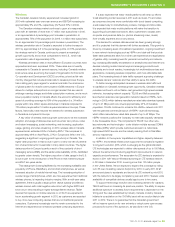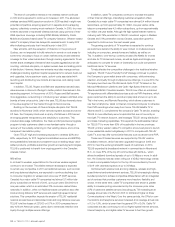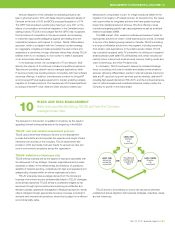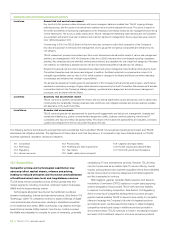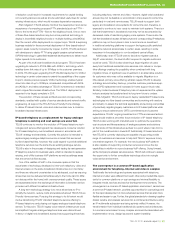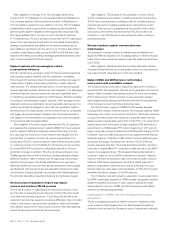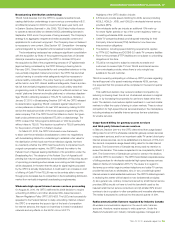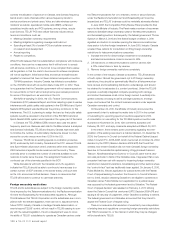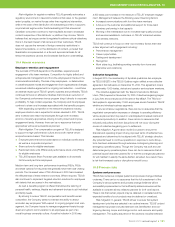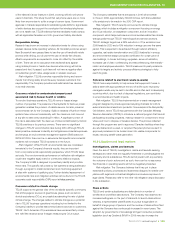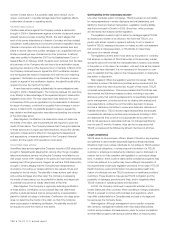Telus 2010 Annual Report Download - page 102
Download and view the complete annual report
Please find page 102 of the 2010 Telus annual report below. You can navigate through the pages in the report by either clicking on the pages listed below, or by using the keyword search tool below to find specific information within the annual report.98 . TELUS 2010 annual report
On April 4, 2007, the Governor in Council issued Order in Council
P.C. 2007-532 and varied Telecom Decision 2006-15 by changing the
criteria for local forbearance for residential and business local exchange
services. Forbearance for residential local exchange service is granted
when there are two independent facilities-based competitors (of which
one can be a wireless service provider) capable of serving at least 75%
of the residential lines in the exchange. For business local exchange
service, forbearance is granted when one facilities-based competitor is
able to serve at least 75% of the business lines. In addition, a number
of quality-of-service indicators must be met for the six-month period prior
to the forbearance application.
Since the Order in Council was issued, TELUS has obtained for-
bearance for about 74% of its local residential service lines and about
75% of local business service lines in B.C., Alberta and Eastern Quebec.
As a result of the forbearance granted for local residential and
business services, TELUS believes it has significantly enhanced flexibility
in pricing, promotions and bundling to compete with other providers
of these services. However, TELUS has no assurance that it will be
able to prevent further market share loss in these markets or that it will
be able to obtain forbearance in other exchanges where it is facing
competition for residential and business customers.
Price cap regulation
Price cap regulation continues to apply to a basket of local services
provided by ILECs. TELUS is subject to price cap regulation as an ILEC
in B.C., Alberta and Eastern Quebec. On April 30, 2007, the CRTC
issued Telecom Decision 2007-27 (third price cap period) and established
an open-ended price cap regime.
During the second price cap period (2002 to 2007), funds were
added to a deferral account as a result of a freeze on residential
telephone rates in urban areas instead of reducing these rates by the
amount required by the price cap formula. The CRTC later determined
that these deferral account funds should be used for broadband
expansion in rural and remote areas and to improve access to telecom-
munications services for the disabled. Any remaining funds were to
be rebated to customers.
On August 31, 2010, the CRTC issued its final determination
on the use of deferral account funds in Telecom Decision 2010-639.
The CRTC finalized the deferral account balance and approved
the use of a portion of the deferral account funds by TELUS to expand
broadband services to 159 communities in B.C., Alberta and Quebec.
The CRTC also directed TELUS to rebate $54.5 million to residential
customers in non-high cost service areas and allowed the Company
flexibility in the method of rebate to such residential subscribers
at the date of the decision, including offering promotions of unrelated
products of greater value than a cash rebate – such promotions to
be concluded by the end of February 2011. The Commission also
approved the use of the balance of the deferral account for broadband
expansion in rural areas of B.C., Alberta and Eastern Quebec over
a period ending in 2014 and finalized amounts to be used for improve-
ment of accessibility for the disabled. On October 29, 2010, Bell Canada
was granted approval to use wireless technology instead of wireline
ADSL technology to provide broadband service to its approved commu-
nities in Ontario and Quebec. However, the deferral account funds
that Bell Canada can use for this broadband expansion were capped
at the amount that it would cost to implement using ADSL technology.
TELUS may also consider using wireless technology to provide
broadband service in some deferral account communities.
10.3 Regulatory
Regulatory developments could have a material impact
on TELUS’ operating procedures, costs and revenues
TELUS’ telecommunications and broadcasting services are regulated
under federal legislation by the Canadian Radio-television and Tele-
communications Commission (CRTC), Industry Canada and Heritage
Canada. The CRTC has taken steps to forbear from regulating prices
for services offered in competitive markets, such as local residential and
business services in selected exchanges, long distance and some data
services, and does not regulate the pricing of wireless services. Local
telecommunications services that have not been forborne are regulated
by the CRTC using a price cap mechanism. A current major area of
regulatory review is the ILECs’ obligation to serve.
The outcome of the regulatory reviews, proceedings and appeals
discussed below and other regulatory developments could have a
material impact on TELUS’ operating procedures, costs and revenues.
Future availability and cost of wireless spectrum
Industry Canada plans to auction spectrum in both the 700 MHz and
2.5/2.6 GHz bands in the late 2011 to 2013 timeframe. There is uncer-
tainty regarding the government’s timing and position in regulating
these potential spectrum bands. Auction rules may, for example, favour
non-incumbents. As the rules for future auctions are unknown, the
capital outlay required to successfully bid on additional spectrum
is uncertain, and how much spectrum will be secured in each region
is unknown. A 700 MHz spectrum auction discussion paper was
issued at the end of 2010 but it is possible that most new spectrum
will not be available for mobile purposes prior to 2012.
Currently, spectrum at 2.5 GHz has been used for fixed wireless
and fixed wireless broadcast applications. However, this spectrum
band has been given a primary mobile designation by Industry Canada
and is expected to become a common global band for mobile services.
In 2006, Industry Canada issued a policy that provides for a clawback
of a portion of the band for auction when mobile service is implemented
within the band, and stated that it intends to auction unassigned
portions of the multipoint distribution service portion of the band. TELUS
expects that an auction discussion paper will be announced by late
2011 and an auction scheduled sometime in 2012 or later.
Competitors Bell and Rogers hold significant amounts of spectrum
at 2.5 GHz through their Inukshuk partnership, and have deployed a
fixed wireless solution for portable DSL service in major cities including
Toronto, Montreal, Calgary, Edmonton and Vancouver. Although TELUS
has experienced only limited competition from this and similar services
to date, there can be no assurance that future marketing of these services
will not negatively impact TELUS’ wireless or wireline services.
Local forbearance
On December 14, 2006, the Governor in Council issued a direction
to the CRTC to:
.Rely on market forces to the maximum extent feasible
.Ensure technological and competitive neutrality and enable
competition from new technologies
.Use tariff approval mechanisms that are as minimally intrusive
as possible
.Complete a review of the framework for mandated access to
wholesale services
.Publish and maintain performance standards for its various processes
.Continue to explore new ways of streamlining its processes.



